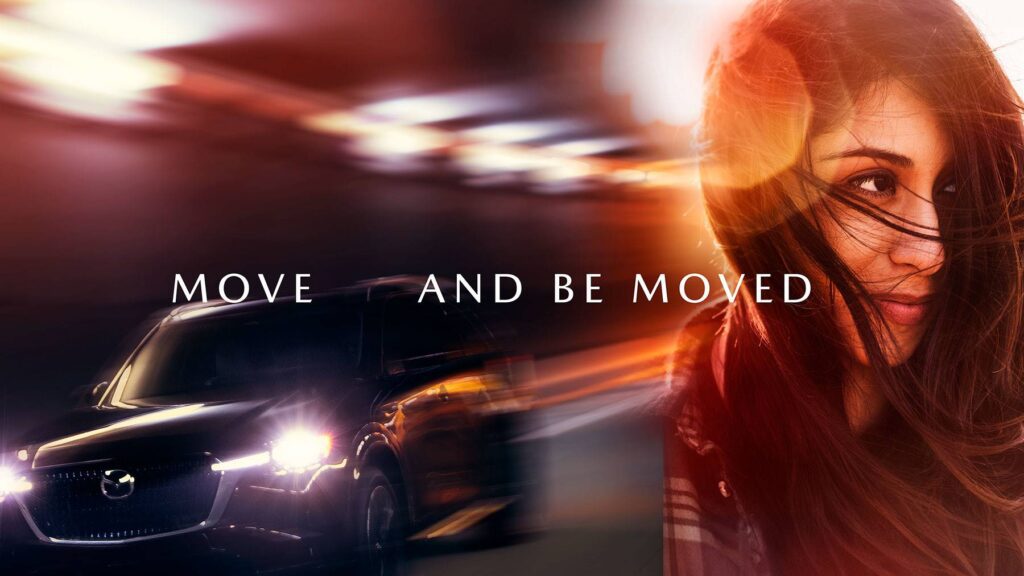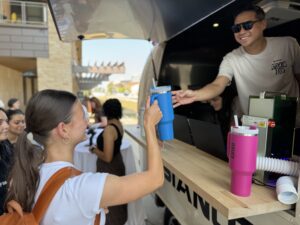On the heels of its best-ever August for U.S. sales, Mazda launched a new brand platform this fall—dubbed “Move and Be Moved”—to reflect its human-centric approach and a new focus on experiences, products and marketing.
It’s more of a “brand aspiration” than a tagline, according to Chief Marketing Officer Brad Audet. “You have the mobility of the product, but it’s also about moving forward in life with intentionality, and then the strong emotional response that you have from being moved. All of those moments accumulate to a life well-lived,” he says.
The brand restructuring follows Mazda’s expansion of its product portfolio and heavy investment in revamping the design and experience of its retail stores—which now account for 89% of the brand’s sales. “The customer satisfaction in those environments is extremely strong,” Audet says. “We have great product, we have great retail experiences, so now is about continuing to build strong desirability and distinctiveness for the Mazda brand.”
Here’s our conversation with Audet about the new brand platform and restructuring; Mazda’s Japanese philosophy and roots; the importance of customer-focused retail experiences; and remaining competitive in the rigorous automotive space.
Chief Marketer: What’s the inspiration behind the Move and Be Moved campaign platform?

Brad Audet, Chief Marketing Officer at Mazda North American Operations: Move and Be Moved is not really a tagline, but more of a brand aspiration. And it’s a succinct expression of what we provide people in terms of actually moving them. And then the emotional piece of it works on numerous levels for us. You have the mobility of the product, but it’s also about moving forward in life with intentionality, and then the strong emotional response that you have from being moved—and all of those moments accumulate to a life well-lived.
That’s really important for us because we’re a brand and a company whose purpose is about enriching the lives of those we serve… It all emanates largely from our soil, so to speak, of Hiroshima and the rebuilding of that community and the central role that Mazda played after the devastation of the bomb. Since then, we’ve always been a company that put people at the center of everything we do.
CM: How does the campaign factor into the overall brand restructuring?
BA: Our business performance has been built around a few things. Number one is, as we look at how we’re restructuring the brand and our go-to-market strategy to drive growth, we’ve expanded our product portfolio. We just launched two large platform products—which are in the mid-crossover segment, so seven-passenger-type vehicles—that represent the next evolution of Mazda products. And those products are being very well received.
At the same time, we have been investing an extraordinary amount of money between ourselves and our dealers to revise our physical stores and the types of experiences that we provide our customers, so [that] we push into a more premium expression. And those retail evolution stores represent 89% of our sales right now. The customer satisfaction in those environments are extremely strong. We have great product, we have great retail experiences, so now is about continuing to build strong desirability and distinctiveness for the Mazda brand.
CM: So the brand component is important now after focusing on the retail experience and increasing sales.
BA: The brand’s always been important. I don’t look at the evolution of the brand as being expressed necessarily just through the marketing or the creative campaign. I think everything that we’ve done from a brand enhancement, from a customer experience enhancement in our retail locations, are all contributors to strengthening the brand.
We had a number of different approaches in the past. Coming out of the pandemic, consumers are wanting more personalized, value-based experiences with brand. They have a yearning for humanity. And I think the time was right for us in terms of continuing our sales trajectory to introduce this into the market now, to continue to grow desirability and distinctiveness for the brand.
It is a bit of a chicken-and-the-egg discussion when you think about this, but I would argue that if we would’ve embarked on a repositioning of the brand several years ago, our retail facilities wouldn’t have been aligned to the customer’s expectations that were created through the marketing. Now, turning on the demand spigot, getting more people to consider Mazda, ensures that they’re going to have a great experience throughout their entire engagement with Mazda.
CM: What are the strategic marketing goals of the brand platform?
BA: Our primary goal is all about brand love, in terms of attracting new people into the Mazda family and also retaining people within the Mazda family. Part of the motivation of our enhanced product portfolio is to offer products for customers at various life stages. I don’t think Mazda is ever going to grow to be the size of a Toyota or a General Motors or anything like that. But we want to grow profitably and provide value to the customers that we serve. In terms of the brand restructuring, ideally we would continue to grow our sales pace between now and 2030, and to do it profitably in a highly competitive, very disruptive U.S. automotive marketplace.
CM: Any other components to the restructuring? What is forthcoming?
BA: Some time ago, our global CMO at the time, who’s now our global CEO, introduced brand value management as a business philosophy to Mazda, where it was about adding more value to the customer and, as a result, the customer [is] willing to pay more for our products. Probably not a revolutionary concept, but it created a discipline and a framework and a structure for us over the decade, where we advanced our product portfolio and we enhanced our store experience. Now we’re repositioning the brand, and for that repositioning—what you’ve seen thus far as the communications aspect of it—there are also a couple other dimensions to that that will be forthcoming.
One of those is how we are going to continue to build on putting people at the center of everything we do, and introducing a Mazda interpretation of omotenashi. Omotenashi is a Japanese term grounded in gratitude and respect and empathy. It basically means that your happiness is my happiness. It’s a very simple way of being selfless in the way that you treat others. I wouldn’t say that it’s a CX program; it’s a belief system that we’re going to drive culturally across all of our stakeholder groups that interface with each other and with our customers. That’s a really important piece of our experience design.
And then further, it’s important that we give back to the communities we serve, both geographic communities and other communities that have shared values with us. We’re going to be introducing a community engagement platform in the near future that will serve to offer another degree of enrichment to those customers that we share mutual bonds with.
CM: Thinking more broadly, what are some of the challenges you face in the automotive space? How are you competing in such a rigorous market?
BA: We have extraordinarily strong relationships with our dealers. When the industry started to make the transition to electrification, there may have been some manufacturers that didn’t feel that they needed the dealers anymore. We believe that the dealers are a strength of ours. And if you think about us being a human-centered brand and putting people at the center, the role of human to human interactions is essential to us. We think that a big piece of our success is because of the strong, respectful relationship and partnership that we have with our dealers.
There are other things that everyone in the industry is trying to navigate around—the regulatory environment, the implications of electrification infrastructure, geopolitical tensions—that collectively as a group we’re all navigating through our trade associations as well as individual companies. Our point of view has been to do what’s right for the customer and put the customer first, and then you have a much greater opportunity for making the right decisions.







